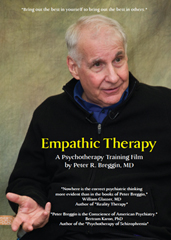The Lobotomists Are Back!
By Dr. Peter Breggin
11/11/2013
Researchers at Laval University in Quebec City, Canada have published a new study of current psychosurgery at their facility, but the project suffers from most of the unconscionable defects associated with the abusive practice of lobotomy in the 1950s. In the U.S., I know of only two places, Harvard and Brown, where they at least put on a show of conducting a genuine experimental protocol with multiple “safeguards” for informed consent and patient rights.
For reasons that remain unexplained, individuals with chronic obsessions and compulsions have become the favorite targets of psychosurgeons in recent years, and this Canadian study reports on treating “severe, refractory OCD.”
Psychosurgery is the mutilation or destruction of normal brain tissue for psychiatric purposes or the control of emotions and behavior. Lobotomy is the best known form of psychosurgery, and as its name suggests it destroys brain tissue in the frontal lobes. The frontal lobes are the seat of all higher human functions including abstract reasoning, judgment, planning, autonomy and independence, self-awareness, social awareness and sensitivity, and love. Other forms of psychosurgery, all of them dating back many decades, assault areas adjacent to and connected to the frontal lobes and have the same or very similar effects as old-fashion lobotomy.
Two definitive follow-up studies made plain how psychosurgery robs the individual of basic human qualities and attributes. In the older 1955 book-lengthy study, P. MacDonald Tow, a pro-lobotomist, summarized the damage as “impairment of the powers of abstraction and synthesis; of perception of relations and differences; of ability to deal with complex situations, planning, and thinking out the next action and its consequences; and appreciation of one’s own mistakes.” (Tow, P. (1955). Personality Changes Following Frontal Leukotomy [lobotomy]. London, Oxford University press, see pages 227-228)
He said further:
Possibly the truest and most accurate way to describing the new effect on the total personality is to say he is more simple; and being more simple he has rather less insight into his own performance (p. 235).
Tow concluded that the “higher mental processes suffer the most” and are “blunted,” that there is a “generalized impairment of mental activity … greater in the higher and more peculiarly human functions” (p. 236). In perhaps the more graphic test of their loss of identity, before a lobotomy most patients were able to write a short biography of several paragraphs about themselves, including their suffering. After lobotomy, they were no longer able to self-reflect sufficiently to write anything meaningful or reflective about themselves.
In 1982 Heidi Hansen, Ruth Anderson and a team of researchers performed the most recent and thorough analysis of the effects of modern psychosurgery (Hansen, H., Andersen, R., Theilgaard, A., and Lunn, V. (1982). Stereotactic psychosurgery: A psychiatric and psychological investigation of the effects and side effects of interventions. Acta Psychiatrica Scandinavica, Supple. 301, Volume 66, Munksgaard, Copenhagen, p. 1-123.) Their detailed monograph concludes that post-psychosurgery patients suffer from “emotional indifference” (p. 111).
The patient’s options for action are reduced by a weakening of initiative and ability to structure his situation; emotionality fades, is organized more shallowly and is more dependent upon the immediate situation. Contact with other people becomes more flattened and the immediate bearing more mechanical (p. 115).
Notice the similarity to Tow’s observations about making the person “more simple.”
The Canadian project is a repetition of the same discredited mutilating operations in use half a century ago. The surgeon does not even use newer and more precise technology available since the 1960s with the implantation of electrodes for stimulation following by heating the tip of the electrode for localized lesions. Instead, a cannula is slipped through a hole drilled on each side the head and wires are pushed down into the brain where they are swished from side to side by hand to slice tissue much as one would dice vegetables.
Four slices were made on each side of the brain in an area called the anterior capsule. The anterior capsule carries nerve fibers that go to and from the frontal lobes. Anterior capsulotomy is in fact a lobotomy using old-fashioned mechanical slicing. This current surgery has exactly the same effect as the oldest forms of lobotomy, which cut fibers at the underside of the frontal lobes on their way to the internal capsule.
Reportedly, the “lesions” or wounds created by the four slices on each side of the brain were approximately four-fifths of an inch by one-quarter inch (11 mm by 5-6 mm). They describe only two dimensions, so that the depth or volume of the wound remains unknown; but these are huge swaths of destruction to impose on a major neuronal pathway going to and from the highest centers of the human brain.
How accurate were they in the placement of their slices? In two cases, postoperative radiology indicated that they didn’t make a large enough cut. They repeated the surgery, inflicting a total of 16 slicing wounds in the brains of the two people.
When fibers are cut in the brain, the attached neurons die. Then neurons adjacent to those cells also tend to die. The damage actually grows over subsequent months in a domino fashion. The authors don’t mention this but do note that the damage causes swelling and inflammation, which in itself is harmful within the closed space of the brain.
Despite well-known studies such as the two quoted above, the Canadian authors completely ignore what psychosurgery routinely does to the whole person. Instead they followed up patients at seven years by phone with untrained interviewers and asked the patients nothing more than a formal list of 10 questions to be rated 0-4 about the presence or absence of obsessions and compulsions.
Patients who reported more than 35 percent improvement over the seven years were considered “responders” who were the most improved. Only 36.8 percent of the patients met this very meager improvement standard. Even if this finding were real, it would hardly justify brain mutilation and its dreadful, dehumanizing consequences.
The fact that lobotomy makes people indifferent to themselves and their plight, including their own psychological symptoms, is never mentioned. Lobotomized patients have little or no ability to understand what has happened to them. We cannot and should not take at face value their responses to a questionnaire on the telephone seven years after the traumatic destruction of portions of their brains.
Typical of all the psychosurgery studies that I have reviewed in my book chapters and articles over many years, this one was filled with multiple other flaws. There was no matching control group of similar OCD patients followed for seven years without psychosurgery. The sample was small, limited to 19 patients with five more lost to follow up.
There were serious casualties of the surgery. The authors report “only two patients had permanent surgical complications.” Only two? That’s an astounding rate of 10.5 percent! Beyond that, “The overall adverse event rate was 57.9 percent,” mostly in the hospital, including a “frontal lobe syndrome” in five patients, which indicates an acute severe lobotomy effect. Some patients had brain hemorrhage and deep vein thrombosis, while “others complained [sic] of pneumonia and urinary tract infection” (p. 4). Tucked into the discussion of “complications” is the mention that two patients were operated on a second time (for a total of 16 lesions in the brain).
This is not science but instead an abuse of helpless human beings. The study is so poorly done and badly skewed in its results that it is shocking that it was published in an established source like the Journal of Neurology, Neurosurgery and Psychiatry. It would be disturbing if this research had been approved by an Institutional Review Board or an Ethics Committee, but none is mentioned, suggesting that the surgeon bypassed any such oversight by claiming to do routine clinical interventions. An inquiry should be conducted into this project by the Canadian government and all other Canadian psychosurgery projects should be brought into public scrutiny.
In the early 1970s I initially became an international reformer when I took several years out of my life to organize a worldwide campaign to stop the return of lobotomy and other forms of psychosurgery. I wrote legislation for Congress that created the federal Psychosurgery Commission, which concluded that the treatment is “experimental” and unsuitable for clinical use. I was the expert in a landmark trial, Kaimowitz v. Michigan Department of Mental Health, which ended psychosurgery in state facilities, National Institutes of Mental Health and the Veterans Administration. I wrote many articles, made innumerable media appearances, and appeared in debates and in the courtroom. The story of that successful reform effort is documented with media reports and testimonials in The Conscience of Psychiatry: The Reform Work of Peter R. Breggin, M.D.
In 1992, Johns Hopkins was champing at the bit to resume psychosurgery. Donlon Long, the chief of neurosurgery, told a friendly author that in order to revive psychosurgery, he and others would “need ‘the guts to tell the Peter Breggins of the world to stuff it’ … referring to psychiatrist Peter Breggin’s lifelong battle to ban psychiatric surgery” (Rodgers, J.E. (1992). Psychosurgery: Damaging the brain to save the mind. New York: HarperCollins, p. 209). Well, they are making a comeback, at least in Canada. I hope many professionals and concerned citizens will join me in an effort to shut down these abusive projects.
In the 1970s, a few brown envelopes without return addresses provided me alleged documentation that helped to stop that resurgence of psychosurgery. I cannot disclose their origin or contents because this would discourage future whistleblowers, but they turned out to be very helpful in the 1970s campaign against psychosurgery. We continue to welcome communications, including anonymously, from anyone who has any information about ongoing psychosurgery projects in North America, as well as the rest of the world. See www.breggin.com for contact information.
Originally published on The Huffington Post.





